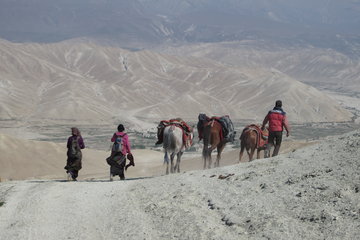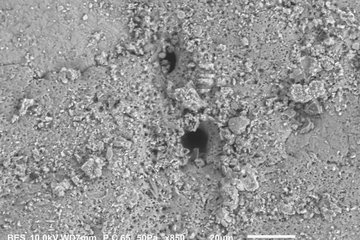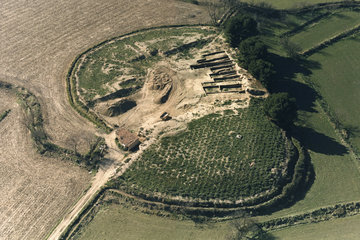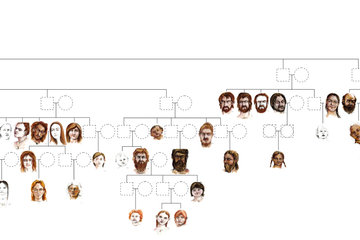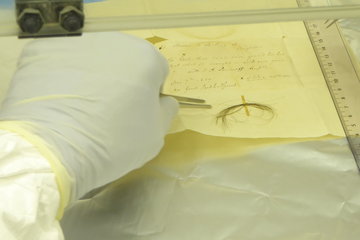Homo naledi - our new relative
Researchers discover a new species of fossil human in a cave in South Africa
The discovery of a new species of human relative was announced today (September 10) by the University of the Witwatersrand, the National Geographic Society and the South African Department of Science and Technology/National Research Foundation (DST/NRF). In addition to shedding new light on the origins and diversity of our genus, the new species, Homo naledi, appears to have intentionally deposited bodies of its dead in a remote cave chamber, a behavior previously thought limited to humans. Researchers of the Max Planck Institute for Evolutionary Anthropology in Leipzig, Germany, took part in the research.

Consisting of more than 1,550 numbered fossil elements, this discovery is the single largest fossil hominin find yet made on the continent of Africa. The initial discovery was made in 2013 in a cave known as Rising Star in the Cradle of Humankind World Heritage Site, some 50 kilometers northwest of Johannesburg, South Africa, by Wits University scientists and volunteer cavers. The fossils lay in a chamber about 90 meters from the cave entrance, accessible only through a chute so narrow that a special team of very slender individuals was needed to retrieve them.
So far the team has recovered parts of at least 15 individuals of the same species, a small fraction of the fossils believed to remain in the chamber. “With almost every bone in the body represented multiple times, Homo naledi is already practically the best-known fossil member of our lineage,” said team leader Lee Berger, research professor in the Evolutionary Studies Institute at the University of the Witwatersrand and a National Geographic Explorer-in-Residence, who led the two expeditions that discovered and recovered the fossils. “This is a tremendously significant find,” said Terry Garcia of the National Geographic Society that provided fundamental support for the project.
H. naledi was named after the Rising Star cave — “naledi” means “star” in the local Sesotho language. “Overall, Homo naledi looks like one of the most primitive members of our genus, but it also has some surprisingly human-like features, enough to warrant placing it in the genus Homo,” said John Hawks of the University of Wisconsin, Madison, U.S. “Homo naledi had a tiny brain, about the size of an average orange, perched atop a very slender body.” The research shows that an average Homo naledi stood approximately 1.5 meters tall and weighed about 45 kilogram.

The teeth are described in the papers as similar to those of the earliest members of our genus, such as Homo habilis, as are most features of the skull. “A number of aspects of the teeth, such as multi-rooted lower premolars, are primitive for our genus and highlight the non-modern nature of the species” said Matthew Skinner of the University of Kent, U.K., and the Max Planck Institute for Evolutionary Anthropology in Leipzig, Germany. The shoulders, however, are more similar to those of apes. “The hands suggest tool-using capabilities,” said Tracy Kivell of the University of Kent, U.K. and the Max Planck Institute for Evolutionary Anthropology in Leipzig. “Surprisingly, Homo naledi has extremely curved fingers, more curved than almost any other species of early hominin, which clearly demonstrates climbing capabilities.”
This contrasts with the feet of Homo naledi, which are “virtually indistinguishable from those of modern humans,” said William Harcourt-Smith of Lehman College, CUNY, and the American Museum of Natural History. This, combined with its long legs, suggests that the species was well-suited for long-distance walking. “The combination of anatomical features in Homo naledi distinguishes it from any previously known species,” added Berger.

Perhaps most remarkably, the context of the find has led the researchers to conclude that this primitive-looking hominin may have intentionally disposed of the dead – a behavior typically considered to be unique to humans. The fossils — which consist of infants, children, adults and elderly individuals — were found in a room deep underground that the team named the Dinaledi Chamber, or “Chamber of Stars,” in Sesotho. That room has “always been isolated from other chambers and never been open directly to the surface,” said Paul Dirks of James Cook University in Australia. “What’s important for people to understand is that the remains were found practically alone in this remote chamber in the absence of any other major fossil animals.”
So remote was the space that out of more than 1,550 fossil elements recovered, only about a dozen are not hominin, and these few pieces are isolated mouse and bird remains, meaning that the chamber attracted few accidental visitors. “Such a situation is unprecedented in the fossil hominin record,” Hawks said. The team notes that the bones bear no marks of scavengers or carnivores or any other signs that non-hominin agents or even natural processes, such as moving water, carried these individuals into the chamber. “We explored every alternative scenario, including mass death, an unknown carnivore, water transport from another location, or accidental death in a death trap, among others,” said Berger. “In examining every other option, we were left with intentional body disposal by Homo naledi as the most plausible scenario.”

The fossil material was recovered in two expeditions conducted in November 2013 and March 2014, dubbed the Rising Star Expeditions. In the initial expedition, over a period of 21 days more than 60 cavers and scientists worked together in what Marina Elliott, one of the excavating scientists, described as “some of the most difficult and dangerous conditions ever encountered in the search for human origins.” Elliott was one of six women selected as “underground astronauts” from a global pool of candidates after Berger issued a call on social media for experienced scientist/cavers who could fit through the 18 centimeter-wide cave opening. Social media continued to play a role in the project, as the team shared expedition progress with a large audience of the public, schoolchildren and scientists.
The fossils were analyzed in a unique workshop in May 2014. More than 50 experienced scientists, including 35 early-career researchers, came together to study and analyze the treasure trove of fossils and compose scientific papers. “This was the first time in palaeoanthropology that hominin fossils had been studied in this way and it was an incredible and productive experience”, says Kivell, who attended the workshop with Skinner.
Much remains to be discovered in the Rising Star cave. “This chamber has not given up all of its secrets,” Berger said. “There are potentially hundreds if not thousands of remains of Homo naledi still down there.”
LB, SJ/HR






